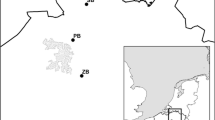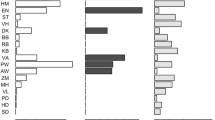Abstract
The role of host size, movement, feeding status, color, and species in the visual host evaluation and recognition behavior of the tick parasitoid, Ixodiphagus hookeri Howard was investigated. Freshly emerged female parasitoids were subjected to a choice bioassay, where the test materials were placed in sealed vials and the vials placed in a Petri dish. When presented with A. variegatum live and mummified nymphs, females examined: larger nymphs significantly longer than smaller nymphs, fed nymphs significantly longer than unfed nymphs, dead and live nymphs for similar lengths of time, and grey live nymphs and yellow-brown and dark brown mummified nymphs for similar lengths of time. The total number of visits to vials containing these test materials were also not significantly different, except there were significantly more visits to yellow-brown mummies when compared to the number of visits to dark brown mummies. When presented with A. variegatum (host) and R. appendiculatus (nonhost) nymphs, the females examined A. variegatum nymphs significantly longer than R. appendiculatus nymphs. The total number of visits to vials containing A. variegatum nymphs were significantly more than the visits to the vials containing R. appendicualtus nymphs. Furthermore, females spent significantly more total examination time per visit on larger and fed A. variegatum nymphs when compared to smaller and unfed nymphs, respectively. Direct and indirect detection were significant when females were presented with fed versus unfed A. variegatum nymphs, grey nymphs versus yellow-brown mummies, and R. appendiculatus versus A. variegatum nymphs. Direct and indirect detection for the rest of the bioassays were not significantly different. Finally, The percentages of females contacting large fed A. variegatum nymphs first were significantly different from those of females contacting small unfed R. appendiculatus nymphs first. The firstcontact percentages for the rest of the bioassays were not significantly different.
Similar content being viewed by others
REFERENCES
Arthur, A. P. (1981). Host acceptance by parasitoids. In Nordlund, D. A., Jones, R. L., and Lewis, W. J. (eds.), Semiochemicals, Their Role in Pest Control, JohnWiley, New York, pp. 97–120.
Bailey, K. P. (1960). Notes on the rearing of Rhipicephalus appendiculatus and their infection with Theileria parva for experimental transmission. Bull. Epizoot. Dis. Afr. 8: 34–43.
Battaglia, D., Pennacchio, F., Romano, A., and Tranfaglia, A. (1995). The role of physical cues in the regulation of host recognition and acceptance behaviour of Aphidius ervi Haliday (Hymenoptera: Braconidae). J. Insect Behav. 8: 739–750.
Bell, W. J. (1991). Searching Behaviour. The Behavioural Ecology of Finding Resources. Chapman & Hall, London.
Branagan, D. (1974). The feeding performance of the ixodid Rhipicephalus appendiculatus Neumann on rabbits, cattle and other hosts. Bull. Entomol. Res. 64: 387–400.
Cooley, R.A. (1928). Preliminary report on the tick parasite, Ixodiphagus caucurtei du Buysson. Seventh Biennial Report, Montana State Board of Entomology, pp. 17–31.
Demas, F. A., Hassanali, A., Mwangi, E. N., Kunjeku, E. C., and Mabveni, A. R. (2000). Cattle and Amblyomma variegatum odors used in host habitat and host finding by the tick parasitoid, Ixodiphagus hookeri. J. Chem. Ecol. 26: 1079–1093.
Godfray, H. C. J. (1994). Parasitoids: Behavioural and Evolutionary Ecology. Princeton University Press, Princeton, NJ.
Hassan, S. M., Dipeolu, O. O., Amoo, A. O. J., and Odhiambo, T. R. (1989). Predation of livestock ticks by chickens. ICIPE Annual Report.
Jackson, D. J. (1958). Observations on the biology of Caraphractus cinctus Walker (Hymenoptera: Miridae), a parasite of the eggs of Dytiscidae. I. Methods of rearing and numbers bred on different host eggs. Trans. R. Entomol. Soc. London. 110: 533–566.
Klomp, H., and Teerink, B. J. (1962). Host selection and number of eggs per oviposition in the egg parasite Trichogramma embryophagum Htg. Nature 195: 1020–1021.
Michaud, J. P., and Mackauer, M. (1995). The use of visual cues in host evaluation by aphidiid wasps. Entomol. Exp. Appl. 74: 267–275.
Mwangi, E. N. (1990). The ecology of free-living stages of R. appendiculatus Neumann and other livestock ticks, and the role of predators, parasitoids and pathogens in the regulation of natural populations. PhD thesis. Kenyatta University, Nairobi, Kenya.
Mwangi, E.N., Dipeolu, O.O., Newson, R. M., Kaaya, G. P., and Hassan, S. M. (1991). Predators, parasitoids and pathogens of ticks: A review. Biocontrol Sci. Technol. 1: 147–156.
Mwangi, E.N., Kaaya, G.P., Essuman, S., and Kimondo, M.G. (1994). Parasitism ofAmblyomma variegatum by a hymenopteran parasitoid in the laboratory, and some aspects of its basic biology. Biol. Contr. 4: 101–104.
Prokopy, R. J., and Owens, E.D. (1983).Visual detection of plants by herbivorous insects. Annu. Rev. Entomol. 28: 337–364.
Salt, G. (1935). Experimental studies in insect parasitism. III. Host selection. Proc. R. Entomol. Soc. London (B). 117: 413–435.
Salt, G. (1938). Experimental studies in insect parasitism. VI. Host suitability. Bull. Entomol. Res. 29: 223–246.
Salt. G. (1958). Parasite behaviour and the control of insect pests. Endeavour 17: 145–148. 494 Demas et al .
SAS (1988). SAS/STAT User's Guide, Release 6.03 ed. SAS Institute Inc., Cary, NC, 1028 pp.
Sokal, R. R., and Rohlf, F. J. (1995). Biometry: The Principles and Practice of Statistics in Biological Research, 3rd ed. W. H. Freeman & Company, New York.
Turlings, T.C. J. Wäckers, F. L., Vet, L. E. M., Lewis, W. J., and Tumlinson, J. H. (1992). Learning of host-location cues by hymenopterous parasitoids. In Lewis, A.C., and Papaj, D. R. (eds.), Insect Learning: Ecological and Evolutionary Perspectives, Chapman & Hall, New York, pp. 51–78.
van Alphen, J. J. M., and Jervis, M. A. (1996). Foraging behaviour. In Jervis, M., and Kidd, N. (eds.), Insect Natural Enemies: Practical Approaches to their Study and Evaluation, Chapman & Hall, London, pp. 1–62.
Wood, H. P. (1911). Notes on the life history of the tick parasite Hunterellus hookeri Howard. J. Econ. Entomol.4: 425–431.
Zar, J. H. (1999). Biostatistical Analysis, 4th ed., Prentice Hall, Englewood Cliffs, New Jersey.
Author information
Authors and Affiliations
Corresponding author
Rights and permissions
About this article
Cite this article
Demas, F.A., Mwangi, E.N., Hassanali, A. et al. Visual Evaluation and Recognition of Hosts by the Tick Parasitoid, Ixodiphagus hookeri (Hymenoptera: Encyrtidae). Journal of Insect Behavior 15, 477–494 (2002). https://doi.org/10.1023/A:1016377132585
Issue Date:
DOI: https://doi.org/10.1023/A:1016377132585




